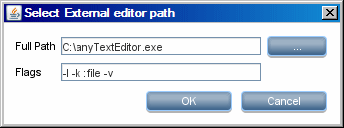Searching the Help
To search for information in the Help, type a word or phrase in the Search box. When you enter a group of words, OR is inferred. You can use Boolean operators to refine your search.
Results returned are case insensitive. However, results ranking takes case into account and assigns higher scores to case matches. Therefore, a search for "cats" followed by a search for "Cats" would return the same number of Help topics, but the order in which the topics are listed would be different.
| Search for | Example | Results |
|---|---|---|
| A single word | cat
|
Topics that contain the word "cat". You will also find its grammatical variations, such as "cats". |
|
A phrase. You can specify that the search results contain a specific phrase. |
"cat food" (quotation marks) |
Topics that contain the literal phrase "cat food" and all its grammatical variations. Without the quotation marks, the query is equivalent to specifying an OR operator, which finds topics with one of the individual words instead of the phrase. |
| Search for | Operator | Example |
|---|---|---|
|
Two or more words in the same topic |
|
|
| Either word in a topic |
|
|
| Topics that do not contain a specific word or phrase |
|
|
| Topics that contain one string and do not contain another | ^ (caret) |
cat ^ mouse
|
| A combination of search types | ( ) parentheses |
|
Script Pane
Enables you to edit a specific script that is part of a package.
| To access | Click a specific script in the Resources pane. |
| Important Information |
The script pane title bar includes the actual physical location of the script. For example, the following script is located in C:UCMDB\DataFlowProbe\runtime\probeManager\discoveryConfigFiles/AMAdapter/META-INF (or probeGateway\discoveryConfigFiles/AMAdapter/META-INF)
|
| See also | Adapter Development and Writing |
User interface elements are described below (unlabeled elements are shown in angle brackets):
| UI Element (A–Z) | Description |
|---|---|

|
Find text. Enables you to find specific text in the script definition. For details, see Find Text Dialog Box. |

|
Go to line. Enables you to jump to a specific line in the script definition. In the Go To Line dialog box, enter the line number, and press Enter. |

|
Open External Editor. Opens the script definition in an external text editor. Prerequisite: Click the Edit the External Editor Preferences |

|
Edit the External Editor Preferences. Click to edit the external editor preferences. You can run the editor by adding flags to the path. Note You cannot specify the file name. Instead, you can use flags relevant to your external editor to retrieve the file name, such as :file. In the following example, :file sets the place of the file in relation to the flags.
If no flags are defined, the file name is automatically added to the end of the path. |

|
Switch Editor Mode. Enables you to switch between the default advanced editor and a simple text editor. |

|
Open Mapping Tool. Enables you to open the new mapping tool window. See Mapping Tool Editor Window. Note: This icon is available for adapter mapping configuration files only.
|

|
Note This button is displayed when a script contains Framework API errors. |
| <script definition> | The Jython script used by the package. For details on working with Jython, see Create Jython Code. |
| Validation Information |
Displays if the script definition is valid or not:
|
We welcome your comments!
To open the configured email client on this computer, open an email window.
Otherwise, copy the information below to a web mail client, and send this email to cms-doc@microfocus.com.
Help Topic ID:
Product:
Topic Title:
Feedback:








 . For Jython files, indicates that the script definition is valid.
. For Jython files, indicates that the script definition is valid. . For Jython files, indicates that the script definition is not valid, and displays the errors in the script.
. For Jython files, indicates that the script definition is not valid, and displays the errors in the script.  . For Jython files, indicates that the script definition could not be validated.
. For Jython files, indicates that the script definition could not be validated.